InterviewSolution
This section includes InterviewSolutions, each offering curated multiple-choice questions to sharpen your knowledge and support exam preparation. Choose a topic below to get started.
| 89401. |
a) Identify the products among the following: |
Answer» SOLUTION :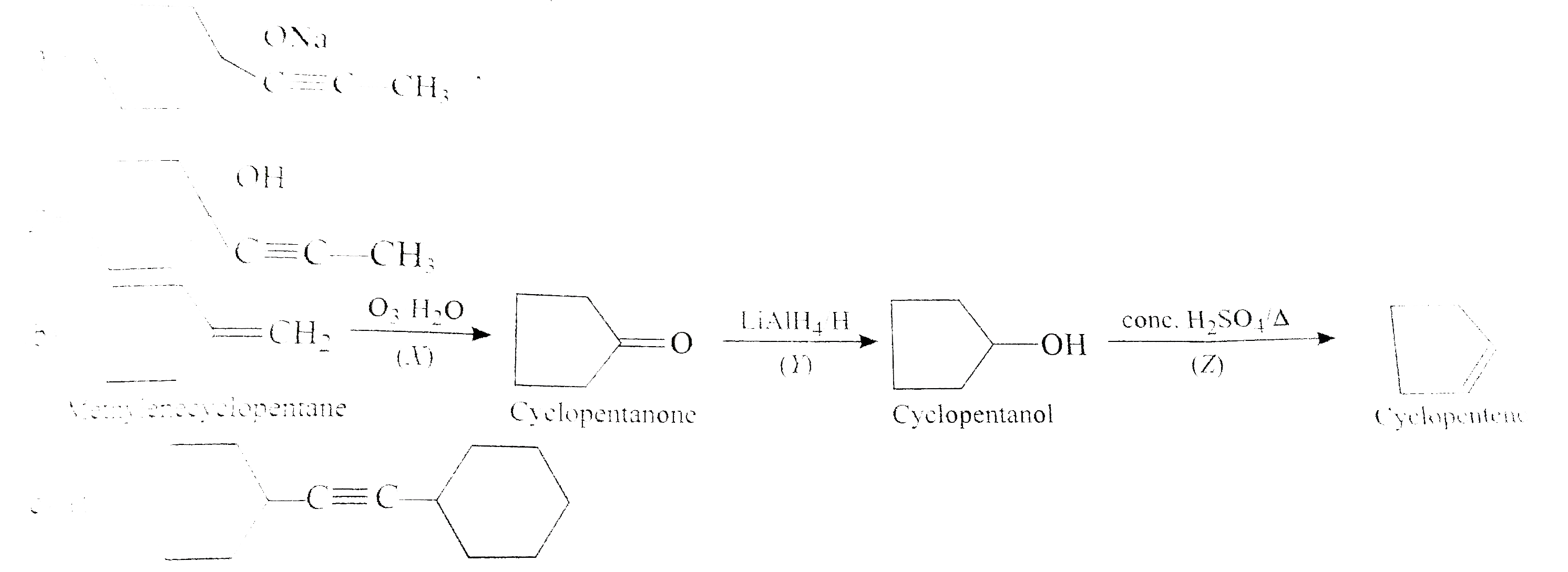
|
|
| 89402. |
a) Identify the product in the following reactions: b) Give the possible mechanism for the following iodolactonization: |
Answer» SOLUTION :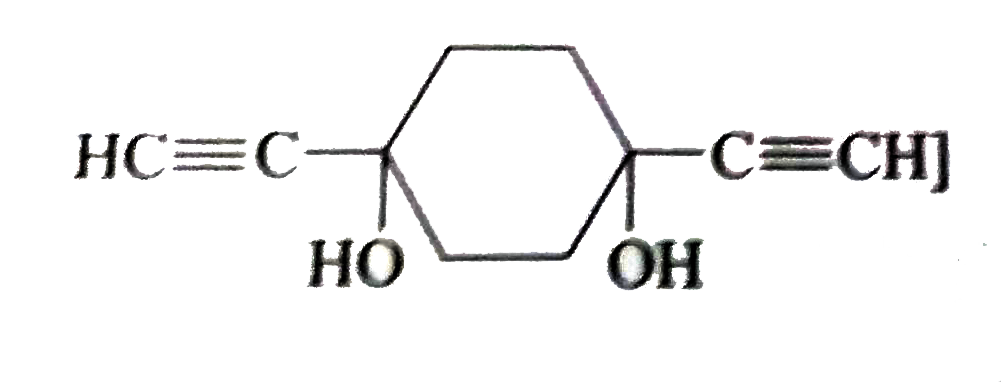
|
|
| 89403. |
a.Identify (A) to (E ) and name the stereoisemer of (B). b. Complete the following reaction: i. ii. iii. c. Give the structure of phosphonium halide, alkyl halide, and carbonyl compound used in the synthesis of following compounds by Witting reaction. i.ii. ltbgt d. Complete the following reactions: |
|
Answer» Solution :i. Proceed reverse: Write the structure of (E ) and (D) FOLLOWED by the REMOVAL of `(-COOH)` group form (E ) and `(-NH_(2))` form (D) to get the structure of R and R' of ketone (A). Substitute R and R' in `(C=O)` group, to obtain the structure of (A). 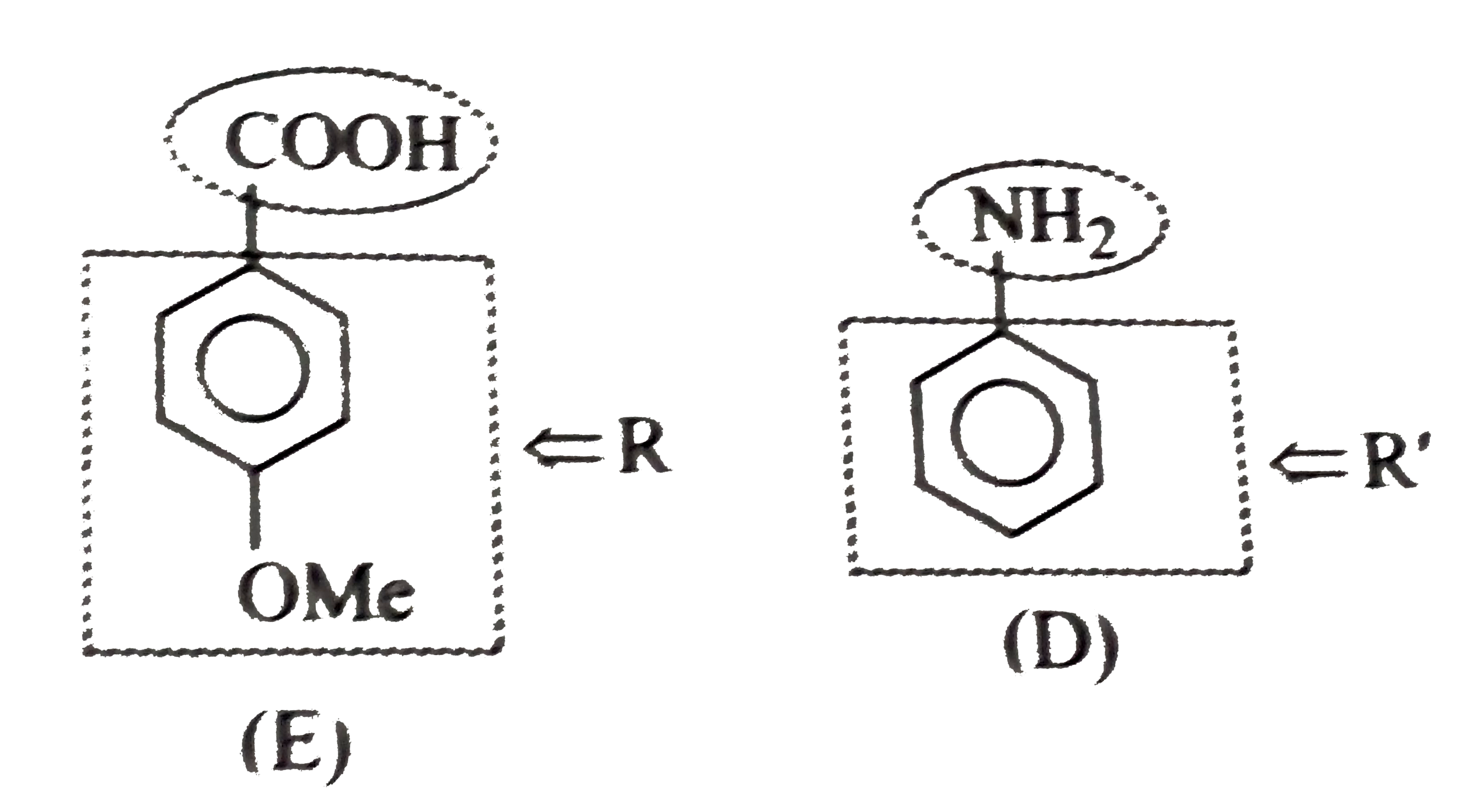 The structure of (A) is: 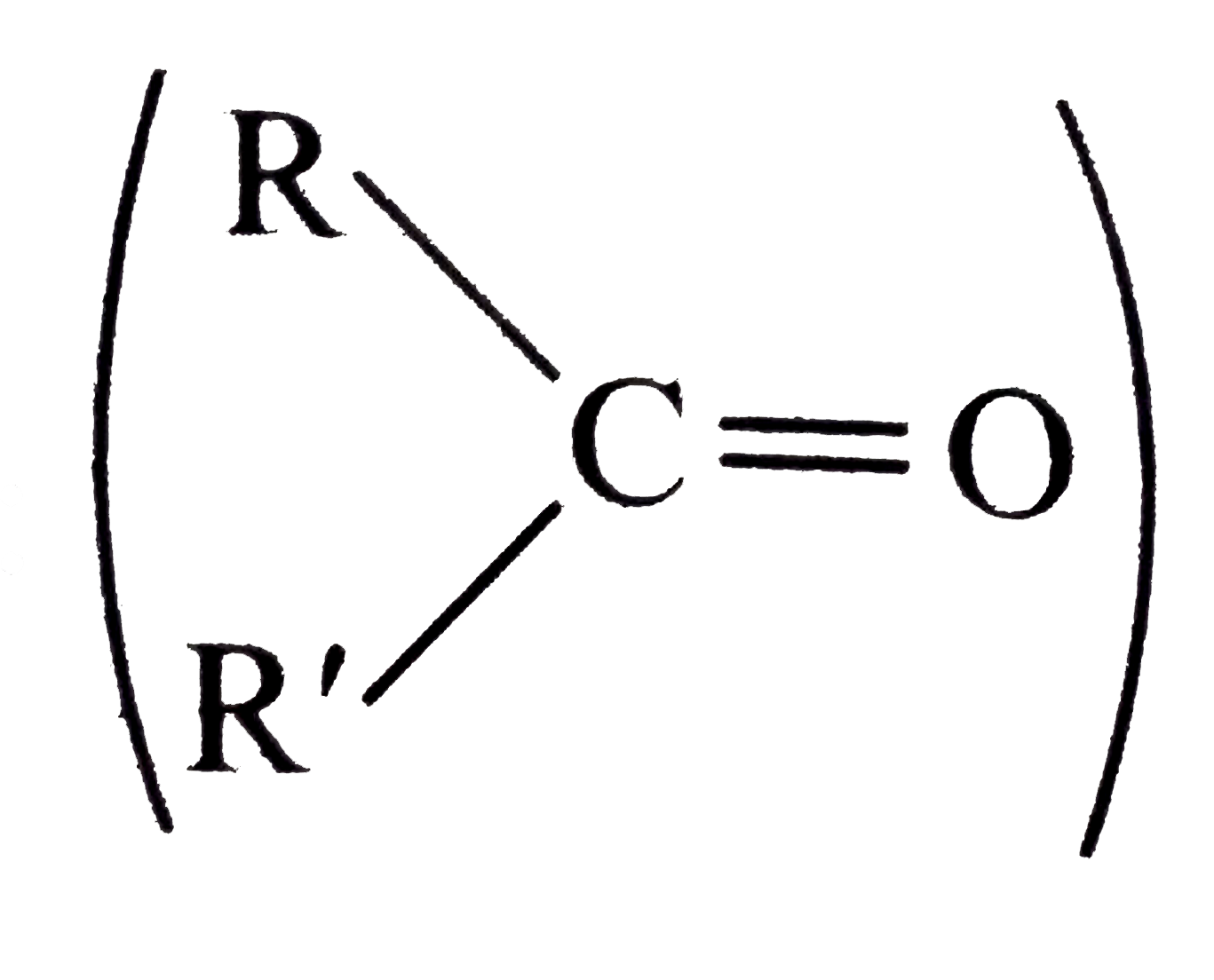  II. Procedure for obtaining the stereoisomers of oxime: It is evident form the mechanism that the group which is anti to (OH) group has migrated form C to N, therefore in oxime in anti-position givesstereoisemer of oxime. Structure of oxime (B).  Altenatively REMEMBER that the group which is attached to `(-NH_(2))` group in amine has migrated. This group and(OH) would always be in anti-posiotive in oxime. Reactions: 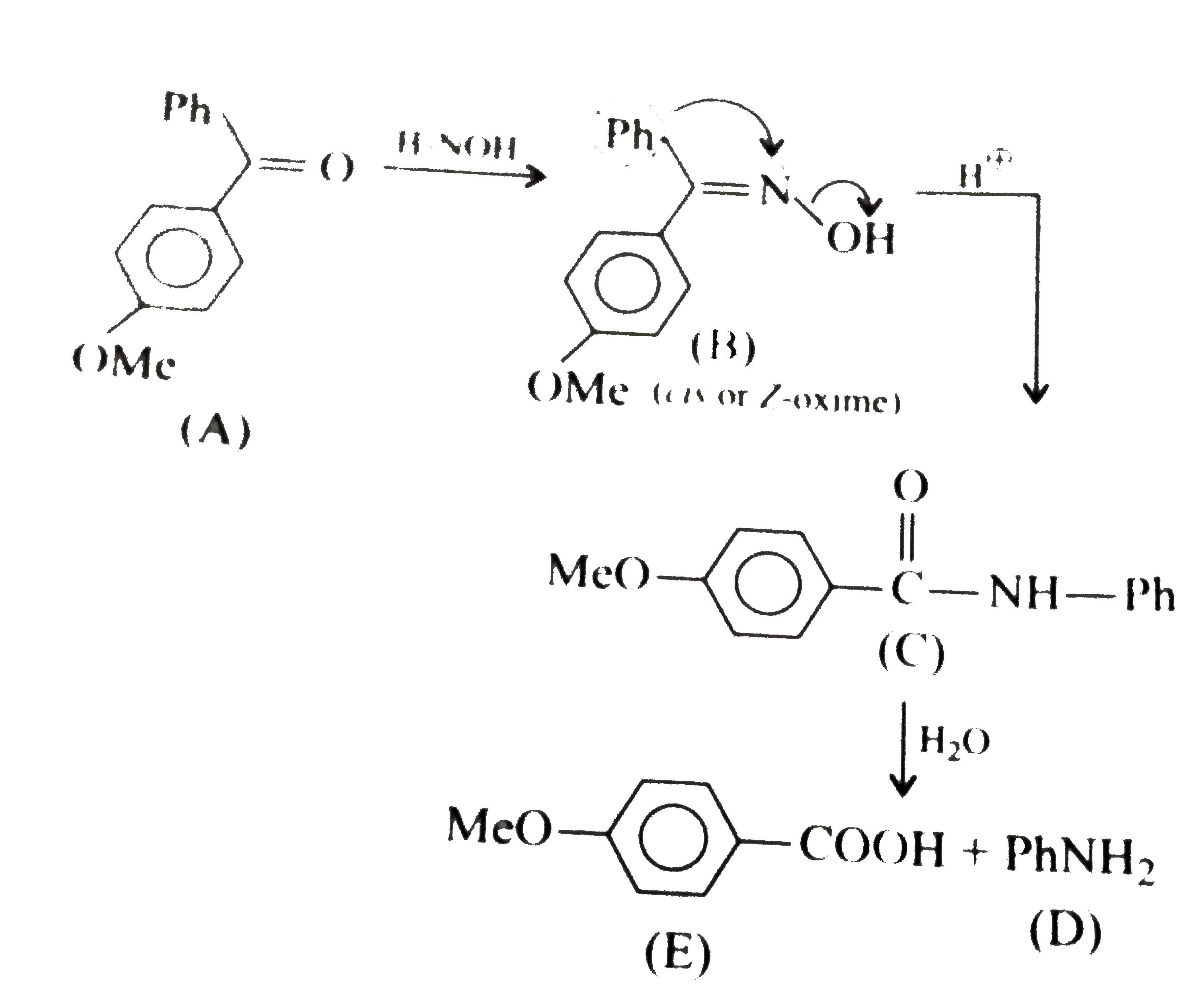 b. i.  ii. 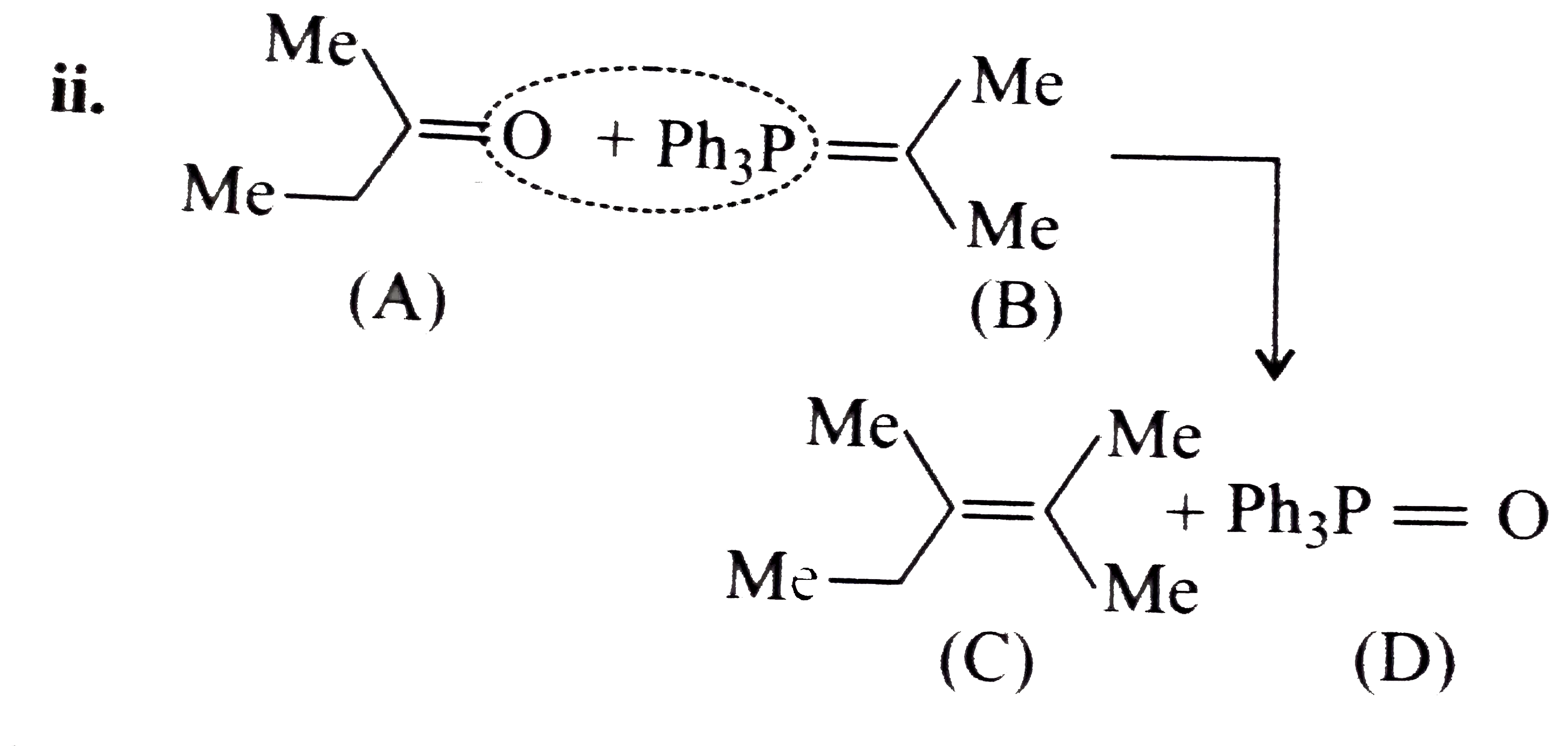 III.Since the stereoisomer of oxime (A) is not given, the Beckmann reaction products (C )and (D) can not be determined. But the formation of cyanide (E) by the reaction of acetylated product of oxime (A) with `Na_(2)CO_(3)` shows that oxime is anti (w.r.t the position of H and OH).  c. Proceed reverse: (First method) i. 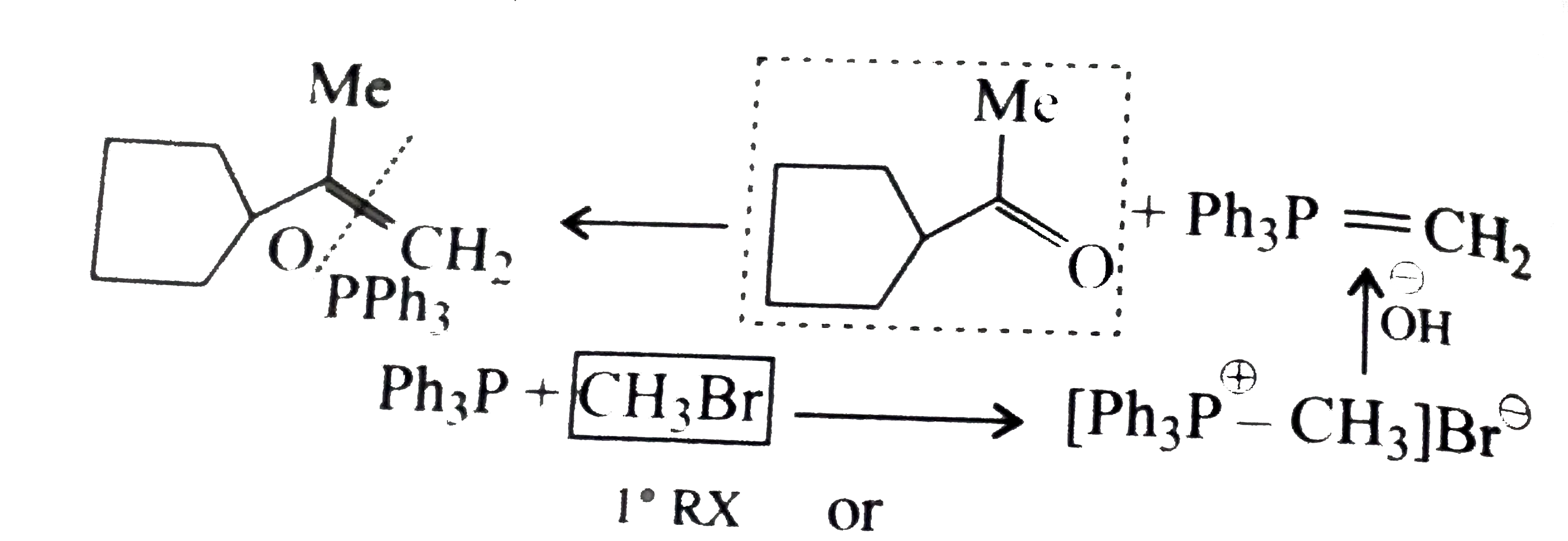 (Second method)  First method is better than the second method because RX used in it is `1^(@)` RX. Reactivity of `SN^(2)` reaction is `1^(@)2^(@)3^(@)`. ii.Proceed reverse: 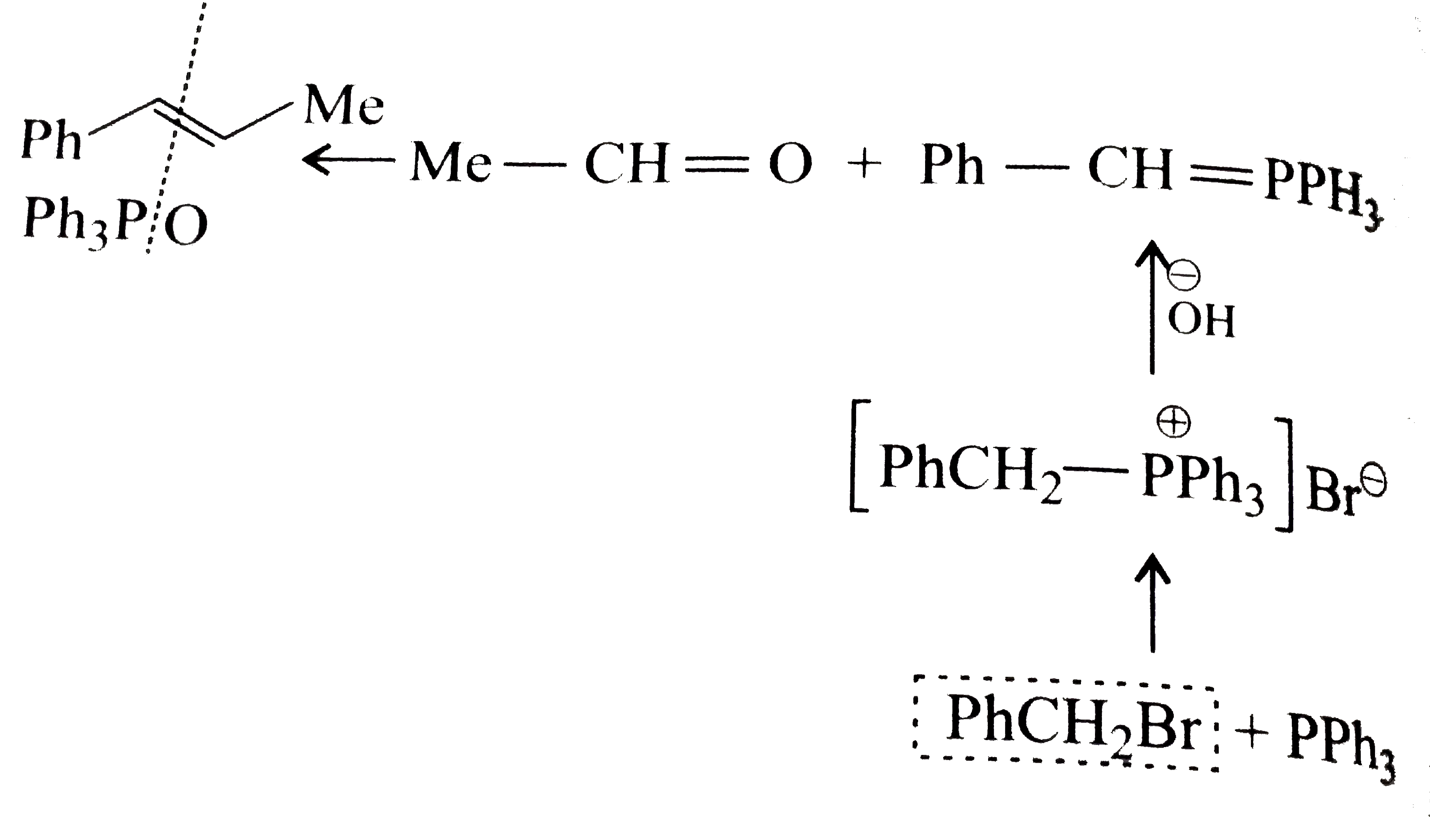 iii. Proceed reverse: First method 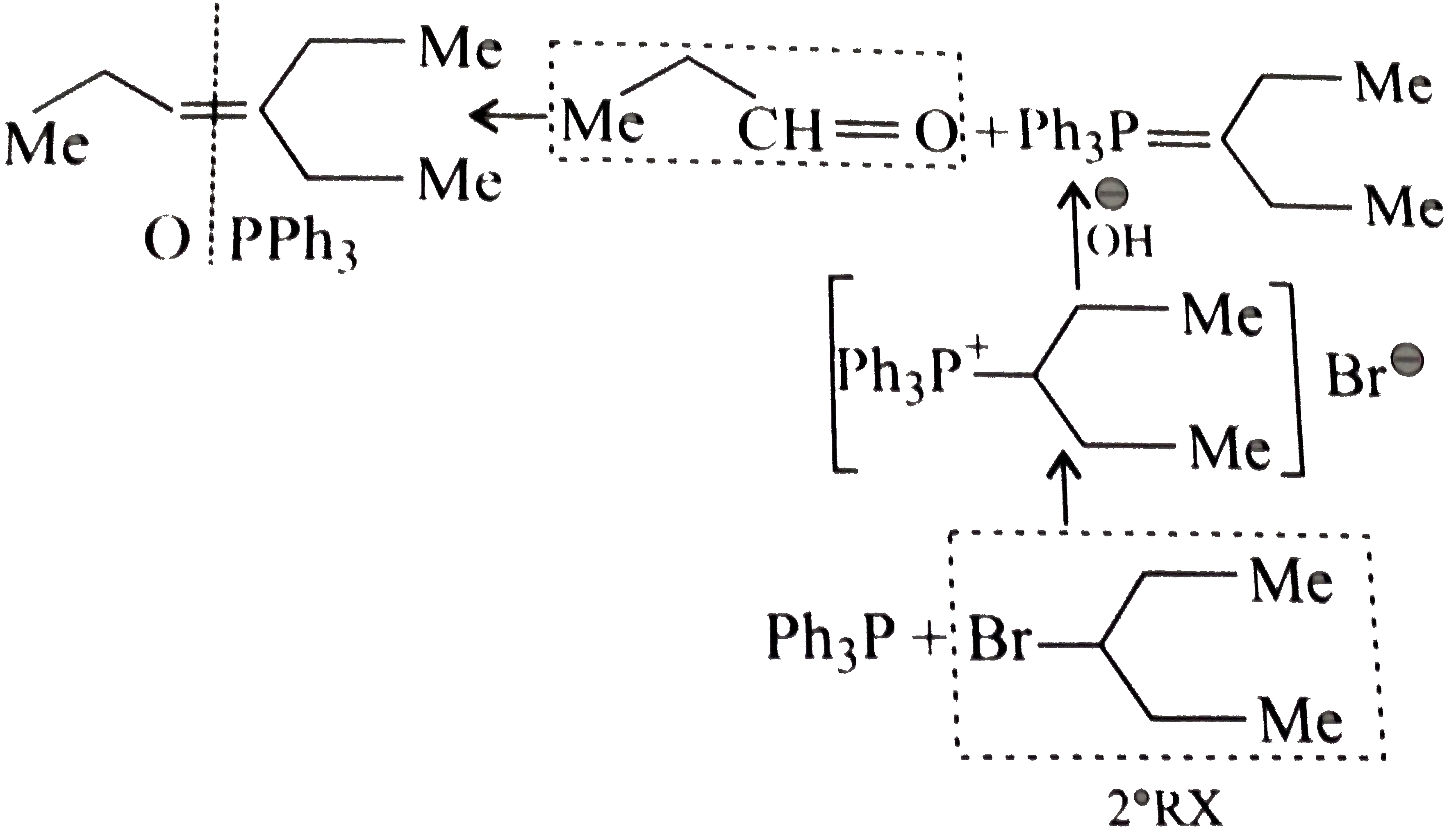 Second method 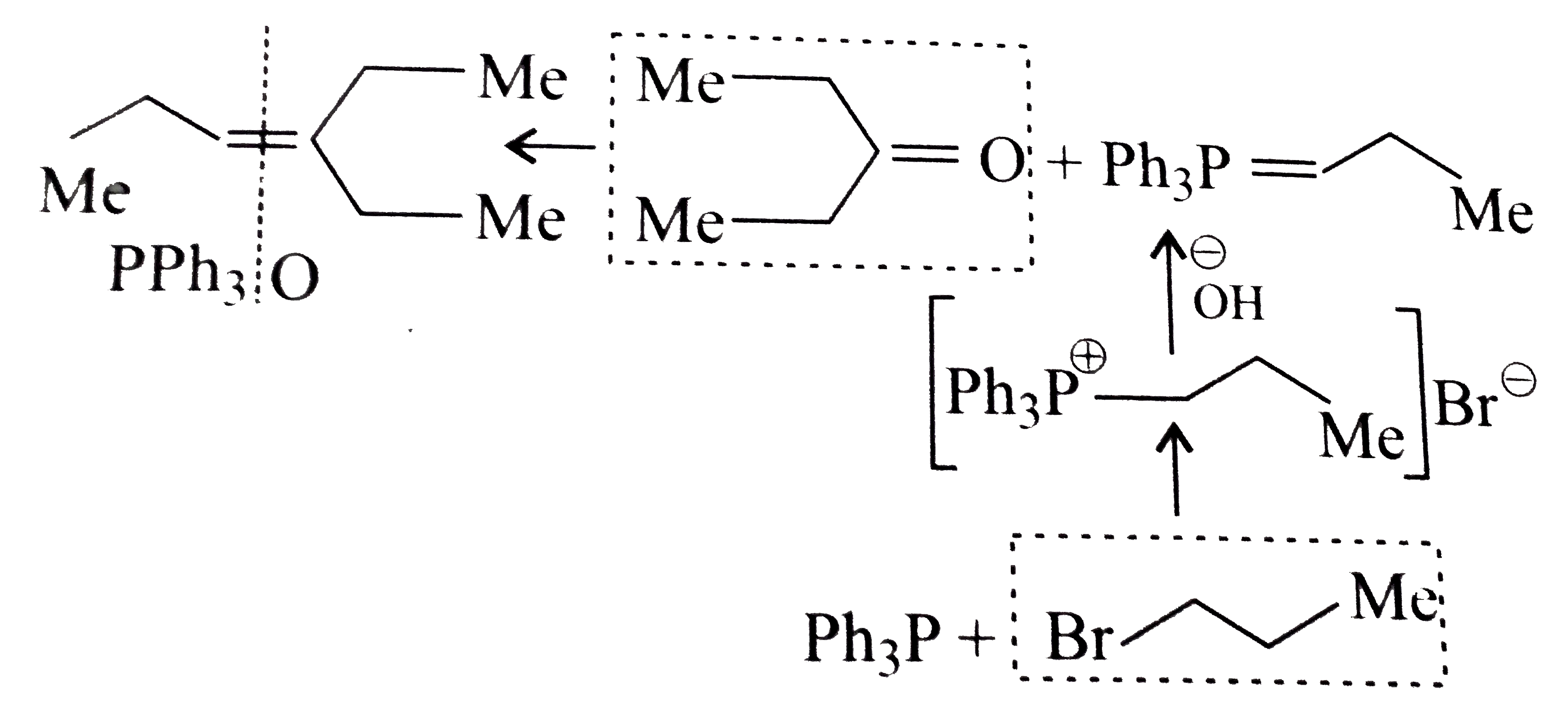 d. i. 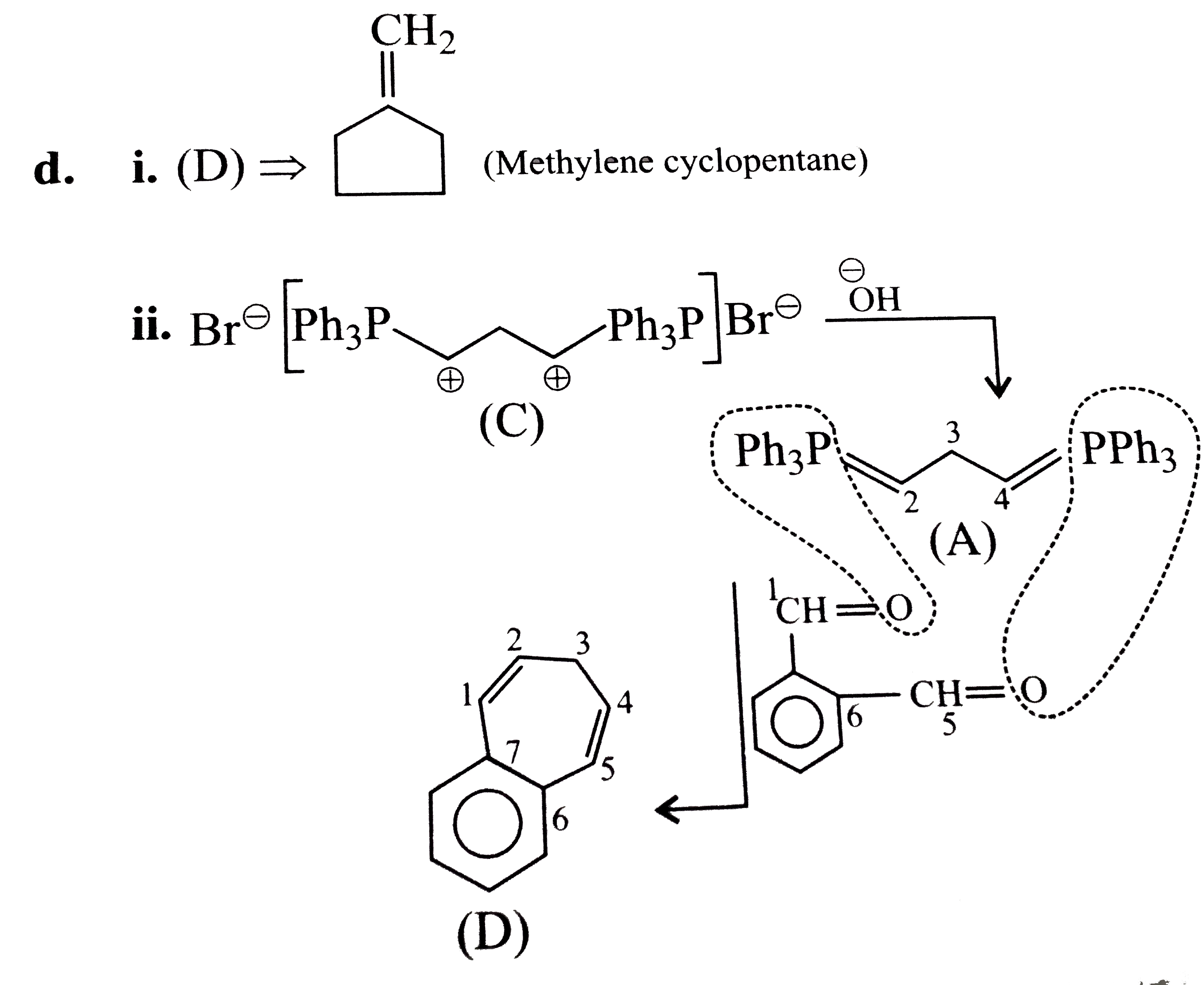 ltbr ii. ltbr ii. 
|
|
| 89404. |
A given nirogen containing aromatic compound 'A' reacts with Sn/HCl, followed by HNO_(2) to give an unstable compound 'B', 'B', on treatment with phenol, forms a beautiful coloured compound 'C' with the molecular formula C_(12)H_(10)N_(2)O. The structure of compound 'A' is |
|
Answer»

|
|
| 89405. |
a. Identify A,B and C in the following sequence of reactions: b. Predict the products of the following reactions: |
Answer» SOLUTION :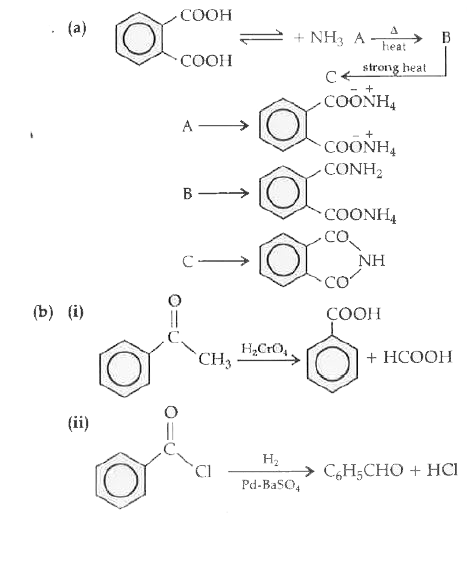
|
|
| 89406. |
A given metal crystallizes out in a cubic structure having edge length of 361 pm. If there are four metal atoms in one unit cell, what is the radius of one atom ? |
|
Answer» 80 pm `r = (361)/(2sqrt2)` = 127 pm |
|
| 89407. |
A given metal crystallises out with a cubic structure having edge length of 360 pm. If there are four metal atoms in one unit cell, what is the radius of one atom ? |
| Answer» ANSWER :D | |
| 89408. |
(A) IC l more reactive than F_(2) (R ) I-Clbond is weaker than F-F bond |
|
Answer» Both (A) and (R ) are TRUE and (R ) is the correct EXPLANATION of (A) |
|
| 89409. |
(A) I_(2)O_(5) is used for the estimation of carbon monoxide in qualitative analysis (R ) I_(2)O_(5) is insoluble and decomposes on heating |
|
Answer» Both (A) and (R ) are TRUE and (R ) is the CORRECT EXPLANATION of (A) |
|
| 89410. |
(a) Give two reasons for the anomalous behaviour of fluorine.(b) Give one example of interhalogen compounds. |
|
Answer» Solution :(a) (i) SMALLEST size(ii) HIGHEST electronegavity (B)`CIF_(3) (or) BrF_(5)`. |
|
| 89411. |
(a) Give the product of debromination with NaI in acetonesolution of the following. (i) Erythro or meso -2,3- dibromobutane (ii) Threo or (+-)-2,3-dibromobutane. (b) Write the structural formulae of the isomers of the alkyl halide , C_(5)H_(11) Br. (w) Which one undergoes E_(1) elimination at the fastesy rate (x) Which one can give only a single alkene on E_(2) elimination ? (y) Which one gives the most complex mixture ofalkenes on E_(2) elimination ? (Z) Which one is incapable of reactingby the E_(2) elimination ? (c) A compound is formed by substitution of two chlorine atoms for two H-atoms in propane . What is the number of structural isomers possible ? |
|
Answer» Solution :(a) (i) TRANS -But -2-ene `("ERYTHRO or meso compound " overset("Anti")underset("elimination")(to) " trans -Alkene ")` (ii) CIS-But-2-ene `(" Three of"(+-) "compound "overset("Anti")underset("elimination")(to) " cis- Alkene ")` (b) Eight isomers : 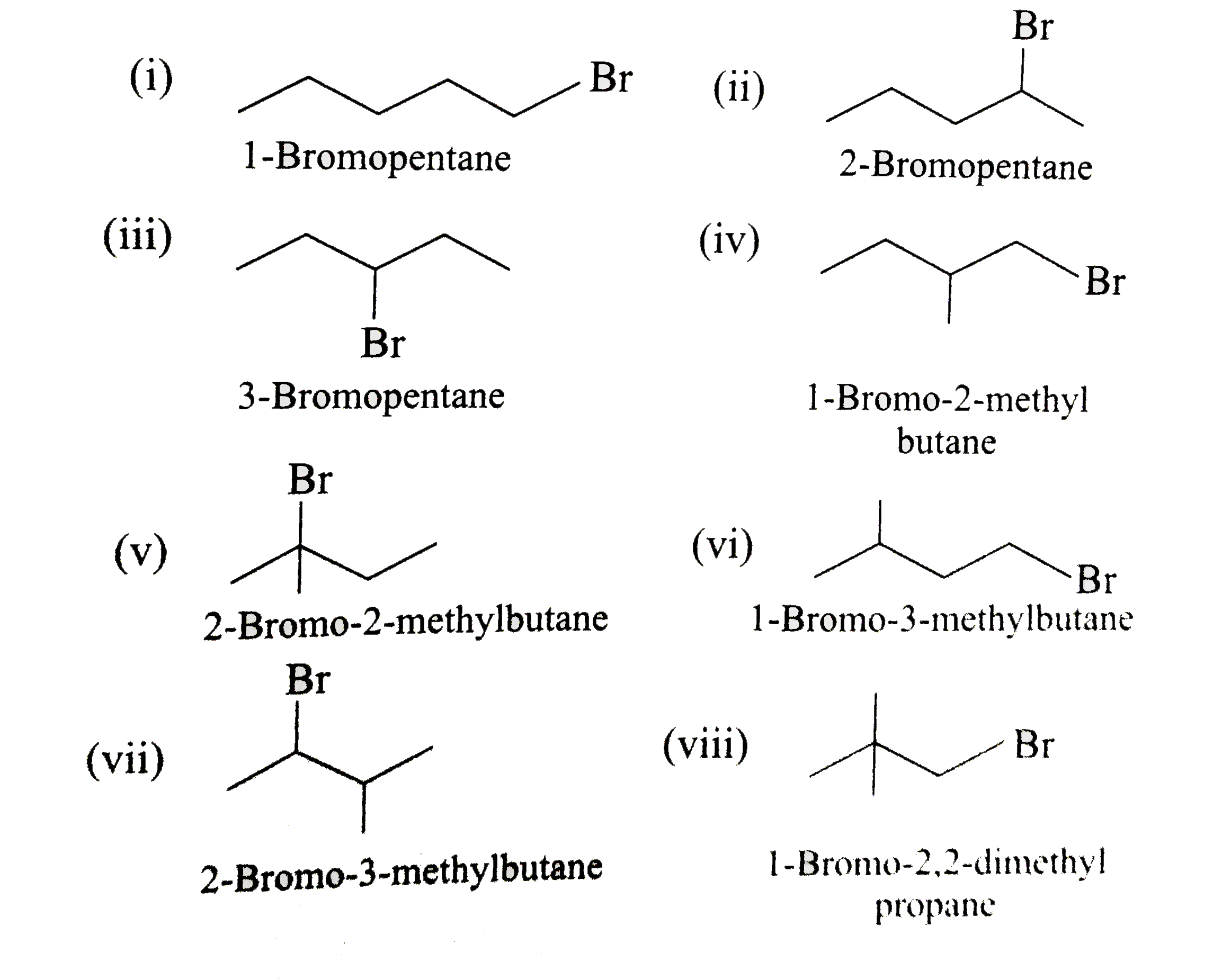 (w) and (v i ii), (x) (i) ,(y) (ii) Pent-1-ene, Pent-2- ene (cis and trans) (z) (iv) (C) Four isomers : `CICH_(2)CH_(2)CH_(2)CI , CH_(3)CHCICH_(2)CI,` `CH_(3)CH_(2)CHCI_(2) , CH_(3)C CI_(2)CH_(3) ,` |
|
| 89412. |
(A) I_(2), CO_(2) have low melting point (R) I_(2), CO_(2)have weak dispersive attractive forces between molecules |
|
Answer» Both (A) and (R) are TRUE and (R) is the correct EXPLANATION of (A) |
|
| 89413. |
(a) (i) Which types of orescan be concentrated by froth floatation method? Give two examples for such ores. (ii) Explain the variation in E_(M^(3+)//M^(2+))^(@) 3d series. |
|
Answer» Solution :(a) (i) Sulphide ores can be concentrated by froth floatation method. e.g., (7) Copper PYRITES `(CuFeS^(2)) (77)` Zinc blende (ZNS) (Hi) Galena (PbS) (II) In transition series, as we move down from Ti to Zn, the standard reduction `E_(M^(2+)//M^(3+))^(@)` values is approaching towards left negative value and copper has a reduction potential. i.e. element copper is more STABLE than `Cu^(2+)`. (ii) `E_(M^(2+)//M)^(@)` value for manganese and zinc are more negative than REGULAR trend. to extra stability arises due to the half filled `d^(5)` configuration in `Mn^(2+)` and completely filled `d^(10)` configuration in `Zn^(2+)`. (iii) The standard electrode potential for the `M^(3+)//Mn^(2+)` half cells give the relative stability between `M^(3+)` and `M^(2+)` (iv) The high reduction potential of `Mn^(3+)// Mn^(2+)` indicates `Mn^(2+)` is more stable than `Mn^(3+)`. (v) For `Fe^(3+)//Fe^(2+)` the reduction potential is 0.77 V, and this how low value indicates that both `Fe^(3+)` and `Fe^(2+)` can exist under normal condition. (vi) `Mn^(3+)` has a `3d^(4)` configuration while that of `Mn^(2+)` is `3d^(5)`. The extra stability associated with a half filled d sub-shell makes the reduction of `Mn^(3+)` very feasible `[E^(@) = +1.51 V]` |
|
| 89414. |
(a) Give three points of difference between lathanoids and actinoids. (b) Give reason and select one atom/ion which will exhibit asked property: (i) Sc^(3+) or Cr^(3+) (Exhibit diamagnetic behaviour) (ii) Cr or Cu (High melting and boiling point) |
|
Answer» Solution :(a) Three points of difference between lanthanoids and actinoids: (i) Electronic configuration : Lanthanoids have electronic configuration with `6s^(2)` common but with variable occupancy of 4f LEVEL. All actinoids have the electronic configuration of `7s^(2)` and variable occupancy of 5f and 6d subshells. (ii) Ionic sizes: There is an overall decrease in atomic and ionic sizes from LA to Lu on account of lanthanoid contraction. In actinoids also, there is an overall decrease in atomic and ionic sizes from Ac to Lr on account of actinoid contraction. But the contraction is greater from element to element resulting from poor shielding by 5f electrons. (iii) Oxidation states: In the lanthanoids, La(II) and Ln(III) compounds are prominent . However +2 and +4 ions in solution or in solid compounds are also obtained. There is a greater range of oxidation states in actinoids which is due to the fact that 5f, 6d and 7s levels are of comparable energies. (b) (i) `Sc^(3+) or Cr^(3+)` (Exhibit diamagnetic behaviour). `Sc^(3+)` is diamagnetic. `Sc^(3+)` has no electrons is 3d and 4s orbitals. The inner shells are completely FILLED and there are no unpaired electrons. Therefore, `Sc^(3+)` is diamagnetic. `Cr^(3+)` on the other hand has the electronic configuration `3d^(3)`. Thus, there are three unpaired electrons and this ion is paramagnetic. (ii) Cr or Cu (High melting and voiling point). CHROMIUM has HIGHER melting and boilingpoint. Chromium has the electronic configuration `3d^(5)4s^(1)`. These six unpaired electrons can form metallic bond with other Cr atoms. Copper has the electronic configuration `3d^(10)4s^(1)`. It has only one unpaired electron for metallic bond formation with other atoms. Therefore chromium has greater strength of metallic bond and hence greater melting and boiling point. |
|
| 89415. |
a) i) write the equations for the steps in SN1 mechanism of the conversion of tertiary butyl bromide in to tertiary butyl alcohol. ii) Haloarenes are less reactive towards nucleophilic substitution reactions than Haloalkanes. Give a reason. |
|
Answer» Solution :a) The mechanism involves the following two steps. Step 1: Formation of carbocation: t-butyl bromide undergoes ionization to form a t-butyl carbocation.  This step is the slowest step hence it is the rate determining step. Step - 2 : Attack of nucleophile on the carbocation : The nucleophile `OH^(-)` can attack the carbocation either from from front side or back side to form t - butyl alcohol. This step is fast.  `THEREFORE` Rate of the reaction is directly `alpha" [ t - butyl bromide]"^(1)[OH^(-)]^(0)` `therefore` ORDER = 1 ii) Haloarences are resonance STABILISED with carbon halogen double bond. |
|
| 89416. |
(a) Give the electronic configuration of d-orbitals of Ti in [Ti(H_(2)O)_(6)]^(3+) ion and explain why this complex is coloured ? (At. No. of Ti = 22) (b) Write the IUPAC name of [Cr(NH_(3))_(3)(H_(2)O)_(3)]Cl_(3). |
| Answer» SOLUTION :triamminetriaquachromium (III) CHLORIDE | |
| 89417. |
(a) Give the mechanism for the formation of ethanol from ethene. (b) Predict the reagent for carrying out of following conversions: (i) Phenol to benzoquinone (ii) Anisole to p-bromoanisole (iii) Phenol to 2, 4, 6-tribromophenol |
Answer» SOLUTION :(a) MECHANISM 
|
|
| 89418. |
(a) (i) Which is stronger reducing agent Cr^(2+) or Fe^(2+) and why? (ii) Explain why Cu^(+) ion is not stable in aqueous solutions. (iii) Explain why Ce^(4+) is a strong oxidising agent. (b) Describe the oxidising property of KMnO_(4) in neutral or faintly alkaline medium for its reaction with iodide ions and thiosulphate ions. |
|
Answer» Solution :(a) (i) `Cr^(2+)` has outer electronic configuration `3D^(4)` and `Fe^(2+)` has outer electronic configuration `3d^(6)`. `Fe^(2+)` after losing one electron will have stable half-filled configuration `3d.^(5)`. Hence, `Fe^(2+)` has greater tendency to lose electron or to act as REDUCING agent. (ii) `Cu^(+)` ion does not have sufficiently negative value of heat of hydration. Therefore, `Cu^(+)` is not stable in aqueous solution. Moreover, it UNDERGOES disproportionation as : `2Cu^(+)toCu^(2+)+Cu` (iii) Although, `Ce^(4+)` is stable due to its noble gas configuration it acts as a strong oxidising agent because in doing so it reverts to the common +3 oxidation state. Potential of `Ce^(4+)//Ce^(3+)` is +1.74 V. (b) Oxidising properties of `KMnO_(4)` in neutral or faintly alkaline medium. Reaction with iodide ions: `2MnO_(4)^(-)+H_(2)O+I^(-)to2MnO_(2)+2OH^(-)+IO_(3)^(-)` Reaction with thiosulphate : `8MnO_(4)^(-)+3S_(2)O_(3)^(2-)+H_(2)O to8MnO_(2)+6SO_(4)^(2-)+2OH^(-)` |
|
| 89419. |
(a) Give S_(N)2 and S_(N)1 mechanisms for the cleavage of ethers with Hl. (b) Why does S_(N)2 cleavage occur at a faster rate with Hl than with HCl? |
Answer» SOLUTION : (B) The transfer of `H^(+)` to ROR. in step 1 is greater with Hl, which is a stronger acid, than with HCl. FURTHERMORE, in step 2, `l^(-)`, being a BETTER nucleophile than `CL^(-)`, reacts at a faster rate. |
|
| 89420. |
i) What type of adsorption involves Van der Waals force of attraction? ii) Give an example for homogeneous catalysis. |
|
Answer» Solution :i) PHYSICAL absorption or physisorption ii) When the REACTANTS and the catalyst are in the same phase (i.e., LIQUID or gas), the process is SAID to be homogenous CATALYSIS. |
|
| 89421. |
(a) Give reasons : (i) Helium does not form compounds like Xenon. (ii) HClO_(4) is a stronger acid than HOCl. (iii) PCl_(5) acts as an oxidising agent. (b) Write one reaction as an example of each, to show that conc. H_(2)SO_(4) acts as (i) an oxidising agent, and (ii) a dehydrating agent. |
|
Answer» Solution :(a) (i) Helium being small in size has a very large value of ionisation enthalpy `(2372" kJ mol"^(-1))`. It has, THEREFORE, no tendency for compound FORMATION. Xenon, on the other hand, has ionisation enthalpy of `1170" kJ mol"^(-1)`. Therefore it can form compounds. (ii) Oxidation number of Cl in `HClO_(4)` is +7 and that of Cl in HClO is +1. Greater the oxidation number, greater is the strength of the acid. (iii) `PCl_(5)` acts as an oxidising agent because oxidation number of phosphorus is decreased in the reaction. Consider the following reaction `2Ag+PCl_(5)to2AgCl+PCl_(3)` `PCl_(5)` has been REDUCED to `PCl_(3)`, thus it has acted as an oxidising agent. (b) (i) `Cu+2H_(2)SO_(4)overset("conc.")toCuSO_(4)+SO_(2)+2H_(2)O` (ii) `underset("Sucrose")(C_(12)H_(22)O_(11))overset(H_(2)SO_(4))to12C+11H_(2)O` |
|
| 89422. |
(a) (i) What is crossed cannizaro reaction ? Explain it . (ii) Complete the following reaction . (b) (i) Is the following sugar , D - sugar or L - sugar ? (ii) Writer a not on vulcanization of rubber. |
|
Answer» Solution :(i) When Cannizaro reaction (Auto redox reaction ) takes place between two different aldehyde, the reaction is called as crossed cannizaro reaction . `underset("Benzaldehyde")(C_6H_5CHO)+underset("formaldehyde")(HCHO)overset(NaOH)rarrunderset("Benzyl alchol")(C_6H_5CH_2OH)+underset("SODIUM formate")(HCOONa)` In crossed cannizaro reaction more REACTIVE aldehyde is oxidized and LESS reactive . (ii)  (b) (i) L - Sugar (ii) 1. Natural rubber is very soft and brisky . it has high water absorption capacity and low tensile strength . Its properties can be improved by a process called vulcanization. 2. Natural rubber is mixed with 3-5% sulphur and heated at `100 - 150^@C` causes cross linking of the cis - 1, 4 polyisoprene chains through disulphide (-S-S-) bonds . The physical properties of rubber can be altered by altered by controlling the amount of sulphur that is used for vulcanization . When 3 to 10% sulphur is used the resultant rubber is somewhat harder but flexible. 4. Following properties of rubber improved by vulcanization: `"*"` Tensile strength `"*"` Elasticity `"*" ` HARDNESS `"*"` Tear strength `"*"` Resistance to solvents 
|
|
| 89423. |
(a) (i) What is Cementation? (ii) Write a notes on ionisation enthalpy in p-block elements? |
|
Answer» Solution :(a) (i) Gold can be recovered by reacting the deoxygenated leached solution with zinc. In this process the gold is reduced to its elemental state (zero oxidation sate) and the process is called cementation. `Zn_((s)) + 2[Au(CN)_(2)]_((aq))^(-) rarr [Zn(CN)_(4)]_((aq))^(2-)+ 2Au_((s))` (II) 1. As we move down a group, generally there is a steady decrease in IONISATION enthalpy of elements due to increase in their atomic radius. 2. In p-block elements there are some minor DEVIATIONS to this general trend. In group 13, from B to Al the ionisation enthalpy decreases as expected. But from Al to TI there is only a marginal difference. This is due to the presence of inner d-and f-elements which has poor shielding effect compared to s and p electrons. As a result, the effective nuclear charge on the valance electrons increase. 3. A similar trend is also observed in group 14. The remaining groups (15-18) follows the general trend, in these groups the ionisation enthalpy decreases as we move down the group. Here poor shielding effect of d-and f-electrons are overcome by the increased shielding effect of the additional p-electrons. 4. The ionisation enthalpy of elements in successive groups is higher than the corresponding elements of the previous group as expected. |
|
| 89424. |
Give reasons: Third ionisation enthalpy of manganese is unusually high. |
| Answer» Solution :a) ii) Third IONISATION ENTHALPHY of manganese is unusually high DUE to `d^(5)` configuration in `MN^(2+)` is disturbed. | |
| 89425. |
(a) (i) Point out the difference between ionic product and solubility product. (ii) The solubility of AgCl in water at 298K is 1.06 xx 10^(-5) mole per litre. Calculate is solubility product at this temperature. |
Answer» Solution :(a) (i)  (ii) The solubility equilibrium in the SATURATED solution is `AGCL(s) rArr AG^(+) (aq) + Cl^(-) (aq)` The solubility of AgCl is `1.06 xx 10^(-5)` mole PER litre. `[Ag^(+) (aq)] = 1.06 xx 10^(-5) mol L^(-1)` `[Cl^(-) (aq)] = 1.06 xx 10^(-5) mol L^(-1)` `K_(sp) = [Ag^(+) (aq)] [Cl^(-) (aq)]` `=(1.06 xx 10^(-5) mol L^(-1)) xx (1.06 xx 10^(-5) mol L^(-1))` `=1.12 xx 10^(-2) mol^(2) L^(-2)` |
|
| 89426. |
(a) Give reasons: (i) Transition metals and their compounds show catalytic activities. (ii) Separation of a mixture of Lanthanoid elements is difficult. (iii) Zn,Cd and Hg are soft and have low melting point. (b) Write the preparation of the following: (i) Na_2Cr_2O_7 from Na_2CrO_4 (ii) K_2MnO_4 from MnO_2 |
|
Answer» SOLUTION :a) (i) Transition metals and their compounds show catalytic activities because of their ability to adopt multiple OXIDATION states and to form complexes. (ii) Identical radii of Lanthanoid elements accounts for their occurrence together and it makes their separation difficult. (iii) The d-orbitals of Zn, Cd and Hg are COMPLETELY filled. As a result, they cannot participate in metallic bonding with other atoms of the same element. Therefore, they are soft and have low melting point. (b) (i) The YELLOW solution and sodium chromate is filtered and acidified with sulphuric ACID to givea solution from which orange sodium dichromate `Na_2Cr_2O_7.2H_2O` can be crystallised. `2Na_2CrO_4+2H^+to Na_2Cr_2O_7+2Na^+ +H_2O` (ii) `K_2MnO_4` from `MnO_2` `MnO_2` is fused with an alkali metal hydroxide and an oxidising agent like `KNO_3` this produces dark green `K_2MnO_4` `2MnO_2+4KOH +O_2 to 2K_2MnO_4+2H_2O` |
|
| 89427. |
(a) (i) Out of coke and CO_3, which is better reducing agent for the reduction of ZaO ? Why? (ii) An element (A) extracted from kernite. A reacts with nitrogen at high temperature give B.A reacts with alkali to from C . Find out A, B and C Give the chemical equations. [OR] (b) (i)Deduce the oxidation number oxygen in hypoflgynous acid-HOF. (ii) Which catalyst is used in the conversion of acetaldehyde to acetic acid ? Given equation . |
|
Answer» Solution :(i) COKE. (C) is a BETTER reducing agent for the reduction of ZnO . Because , when we use coke, the reduction can be EASILY carried out at 673 K. Thus carbon (Coke) reduces zinc oxide more easily than carbon monoxide (CO). From the Ellingham diagrams , it is quite clear that the reduction of zinc oxide is more favorable using coke (`DeltaG` for the formation of carbon monoxide from carbon is more negative ). (ii)An element (A) extracted fromkernite is boron. `"*"` Boron reacts with nitrogen at high temperatures to give Boron nitride (B) `underset((A))(2B)+N_2overset(Delta)rarrunderset((B))(2BN)` `"*"` Boron reacts with alkali (NaOH) to give sodium borate (C) . `underset((A))(2B)+underset(("Sodiumbydroxide"))(6NaOH)rarrunderset((C))(2Na_3BO_3+3H_2)` `{:(A,"Boron",B),(B,"Boron nitride",BN),(C,"Sodium borate",Na_3BO_3):}` (b)  In CASE of O - F bond is HOF , fluorine is most electronegative element . So its oxidation number is - 1 . Therefore oxidation number of O is +1 . Similarly in case of O - H bond is HOF. O is highly electronegative than H. So its oxidation number is - 1 and oxidation number of H is + 1 . So Net oxidation of oxygen is - 1 + 1 = 0 . (ii) `underset("Acetaldehyde")(CH_3-CHO+O)overset(Rh//Ir"complex")underset("oxidation")rarrCH_3-underset("Acetic acid")(COOH)` |
|
| 89428. |
a) i) Name the product liberated at anode when dil. H_(2)SO_(4) is electrolysed. |
| Answer» Solution :i) The product LIBERATED at anode when dil `H_(2)SO_(4)` is electrolysed is oxygen, GAS. | |
| 89429. |
Give reasons: i) Generally there is increase in density along 3d series of transition metals. |
| Answer» Solution :a) i) GENERALLY there is increase in density ALONG 3d series of a TRANSITION metals due to decrease in metallic radius COUPLED with increase in atomic mass CAUSES increase in density. | |
| 89430. |
i) Name the water insoluble component of starch. ii) Mention one water soluble vitamin. iii) Is Lysine an essential or non-essential amino acid? |
|
Answer» Solution :a) i) The water insoluble component of STARCH amylopectin. II) Vitamine C or Vitamine K. iii) Essential AMINO acid. |
|
| 89431. |
i) Name the polymer whose partial structure is represented by ii) What are the monomers of Nylon 6, 6 ? |
|
Answer» SOLUTION :a) i) It si prepared by addition polymerisation of acrylonitrite in PRESENCE of peroxide catalyst The partial structure polymer is  ii) The MONOMERS present in nylon 6, 6 is 1) Hexa methylene diamine `NH_(2)-(CH_(2))_(6)-NH_(2)` 2) ADIPIC acid `HOOC - (CH_(2))_(4)-COOH` These two monomers undergoes (copolymerisation) condensation polymerization to form nylon - 66 i.e., `underset("Henametylene dumine")(NH_(2)-(CH_(2))_(6)-NH_(2))+underset("Adipic acid")(HOOC-(CH_(2))_(4)-COOH)rarr underset("Nylon - 66")([NH-(CH_(2))_(6)-NH-overset(O)overset(||)C-(CH_(2))_(4)-overset(O)overset(||)C-]_(n))` |
|
| 89432. |
(a) Give reasons : (i) Although-NH_(2) group is o/p directing in electrophilic substitution reactions, yet aniline, on nitration gives good yield of m-nitroaniline. (ii) (CH_(3))_(2)NH is more basic than (CH_(3))_(3)N in an aqueous solution. (iii) Ammonolysis of alkyl halides is not a good method to prepare pure primary amines. (b) Distinguish between the following : (i) CH_(3)CH_(2)NH_(2) and (CH_(3)CH_(2))_(2)NH (ii) Aniline and CH_(3)NH_(2) |
|
Answer» Solution :(a) (i) In acidic medium, aniline is protonated to form to anilinium ion which is meta directing. That is why a good yield of m-nitroaniline is also obtained. (ii) There is greater solvation of substituted ammonium cation due to the presence of two hydrogens in SECONDARY amine compared to ONE hydrogen in tertiary amine. Due to COMBINED effect of inductive effect and solvation effect, `(CH_(3))_(2)NH` is more basic than `(CH_(3))_(3)N`. (iii) This is because ammonolysis yields a mixture of primary, secondary, tertiary and quaternary ammonium salt. (B) (i) `CH_(3)CH_(2)NH_(2)` and `(CH_(3)CH_(2))_(2)NH` The two compounds can be distinguished with Hinsberg.s reagent. The reaction of benzenesulphonyl chloride with `CH_(3)CH_(2)NH_(2)` gives N-Ethylbenzenesulphonamide which is soluble in alkali. The compound obtained with `(CH_(3)CH_(2))_(2)NH` is not soluble in alkali. (ii) Aniline and `CH_(3)NH_(2)` `CH_(3)NH_(2)` reacts with nitrous acid to liberate nitrogen gas. Aniline does not evolve `N_(2)` gas but forms a diazonium salt at 273-278 K. |
|
| 89433. |
(a) (i) Name the organic product formed when chloroalkane is heated with concentrated solution of sodium iodide (Nal) in acetone?(ii) Write the chemical equation for the above reaction(iii) Name the above reaction. (b) Explain Fittig's reaction with an equation. |
|
Answer» SOLUTION :(a) (i) When chloroalkane is heated with concentrated solution of sodium iodide iri acetone, iodaalkane is formed. (ii) `R-Cl + Nal overset("Acetone")(to) R-I + NaCl` (iii) FINKELSTEIN Reaction (b) When haloarene is heated with sodium metal in DRY ether medium, higher AROMATIC hydrocarbon is formed. `C_(6)H_(5)-X + 2Na + C_(6)H_(5)-X overset(dry ether)(to) C_(6)H_(5)- C_(6)H_(5) + 2Na x`. |
|
| 89434. |
(a) (i) How is the variability in oxidation states of transition metals different from that of the p-block elements ? (ii) Out of Cu^(+) and Cu^(2+), which ion is unstable in aqueous solution and why ? (iii) Orange colour of Cr_(2)O_(7)^(2-) ion changes to yellow when treated with an alkali. Why ? (b) Chemistry of actinoids is complicated as compared to lanthanoids. Given two reasons |
|
Answer» Solution :(a) (i) The variability in oxidation state of TRANSITION metal is due to the incomplete FILLING of d-orbitals in such a way, that their oxidation states differ from each other by unity, e.g., `Fe^(2+) and Fe^(3+)` etc. In case of P-block elements, the oxidation state differ by units by two, e.g. `+3 and +5`. MOREOVER, in transition elements, the higher oxidation states are more stable for heavier elements in a group, e.g., `Mo^(+6)` is more stable than `Cr^(4+)`. In P-block elements, the lower oxidation states are more stable for heavier members due to inert pair effect, e.g., `Pb^(2+)` is more stable than `Pb^(4+)`. (ii) `Cu^(+)` is unstable in aqueous solution than `Cu^(2+)`. This is because, although `2^(nd) I.E` of copper is large but hydration enthalpy for `Cu^(2+)` is much more negative than that or `Cu^(+)` and compounds are unstable in aqueous solution and undergo disproportionation. `2Cu^(+) rarr Cu^(2+) + Cu` (iii) Orange colour of `Cr_(2)O_(7)^(2-)` ion changes to yellow when treated with an ALKALI because of the formation of chromate ions `{:(Cr_(2) O7^(2-) + 2OH^(-),rarr,2CrO_(4)^(2-) + H_(2)O),("Dichromate ion",,"Chromate ion"),("(orange)",,"(yeloow)"):}` (b) Chemistry of actinoids is complicated as compared to lanthanoids because: (i) actinoids show wide range of oxidation states i.e., `+3, +4, +5, +6` due to small energy difference between `5f, 6d and 7s` subshells of actinoids. (ii) actinoids are radioactive due to that, chemistry of actinoids is complicated. |
|
| 89435. |
(a) Give reasons for the following observations: (i) Cu^(+) ion is not stable in aqueous solution. (ii) Mn (II) ion shows maximum paramagnetic character amongst the bivalent ions of first transition series. (iii) Scandium (At. no. 21) salts are white. (b) Describe the reactions involved in the preparation of K_2Cr_2O_7 from chromite ore. |
|
Answer» Solution :(a) (i) `Cu^(+)` is unstable in aqueous solution due to LOWER hydration energy and HIGHER reduction potential. (ii) `Mn^(2+)` ion shows MAXIMUM para-magnetic character amongst the bivalent ions of first transition series : Configuration of `Mn^(2+)` is `3d^5 4s^2` because `Mn^(2+)` has configuration `3d^5 (##OSW_SP_CHE_XII_C08_E01_101_S01.png" width="80%">as it has MAX no. of unpaired `e^(-)`, hence paramagnetic in nature. (iii) Scandium salts are white in colour : Scandium shows only +3 oxidation state, i.e. outermost configuration `3d^(0) 4s^(0)` in which it does not have any unpaired `e^(-)`, due to which it is colourless. (iii) Ionisation enthalpies. |
|
| 89436. |
(a) (i) Identify 'A' and 'B' in the folowing equation. (ii) What is Lucas reagent ? (b) Explain Williamson Ehter synthesis . |
|
Answer» SOLUTION : (i)`A=CH_3- underset (OH) underset(|)(CH)-CH_3``B= CH_3- underset(O)underset(||)(C) -CH_3` (ii) `R-X=R-O-Na toR-O-R^1+NaX` `R=CH_3R^1= C_2H_5X=Cl` `CH_3-Cl+C_2H_5-O Na to CH_3 -O-C_2H_5 + NACL` |
|
| 89437. |
(a) (i) How is the variability in oxidation states of transition metals different from that of the p-block elements ? (ii) Out of Cu^(+) and Cu^(2+) which ion is unstable in aqueous solution and why ? (iii) Orange colour of Cr_(2)O_(7)^(2-) ion changes to yellow when treated with an alkali. Why ? (b) Chemistry of actinoids is complicated as compared to lanthanoids. Give two reasons. |
|
Answer» Solution :(a) (i) In the p-block, the lower oxidation states are favoured by heavier elements due to inert pair EFFECT, the opposite is true in the case of d-block. For example, in group 6, Mn(VI) and W(VI) are found to be more stable than Cr(VI). (ii) `Cu^(+)` is unstable in aqueous solution due to disproportionation. `2Cu^(+)toCu^(2+)+Cu` Greater stability of `Cu^(2+)` (AQ) rather than `Cu^(+)` (aq) is due to much more negative `Delta_(hyd)H^(0)` of `Cu^(2+)` (aq) than `Cu^(+)`, which more than compensates for the second ionisation enthalpy of Cu. (iii) Orange colour of `Cr_(2)O_(7)^(2-)` ion changes to yellow when TREATED with an alkali because of the following reaction : `Cr_(2)O_(7)^(2-)+2OH^(-)to2CrO_(4)^(2-)+H_(2)O` (b) Chemistry of actinoids is complicated as compared to lanthanoids. The reasons are : (i) Actinoids exist in different oxidation states. (ii) Many of the actinoids are RADIOACTIVE. |
|
| 89438. |
(a) Give reasons for the following : Phenol does not undergo protonation readily. (b) Give chemical test to distinguish between the followings pairs of compounds -2- butanol and 2-methyl -2- propanol. |
|
Answer» Solution :(a) In phenol, there is `+ve` charge on oxygen in its RESONATING structures, THEREFORE, it does not undergo protonation easily. (b) Add `I_(2)` and `NaOH` to the compound, 2- BUTANOL will give yellow PRECIPITATE DUE to formation of iodoform whereas 2-methyl-2- propanol will not react. |
|
| 89439. |
i) How do you convert benzoic acid to benzamide? Write the reaction. ii) Complete the reaction: |
Answer» SOLUTION :a) i) when benzoic acid treated with AMMONIA, ammonium benzoate is OBTAINED which on heating gives benzamide. 
|
|
| 89440. |
(a) Give reasons for the following: (i) Mn^(3+) is a good oxidising agent. (ii) E^(@)_(M^(2+)//M) values are not regular for first row transition metals (3d series). (iii) Although 'F' is more electronegative than 'O', the highest Mn fluoride is MnF_(4), whereas the highest oxide is Mn_(2)O_(7). (b) Complete the following equations : (i) 2CrO_(4)^(2-)2H^(+)to (ii) KMnO_(4)overset("heat")to |
|
Answer» Solution :(a) (i) Electronic configuration of `Mn^(3+)` is `d^(4)` in the outer shell. It acts as oxidising AGENT or it gets reduced to `Mn^(2+)`. In doing so its configuration changes to do which is a half-filled stable configuration. (ii) `E^(@)_(M^(2+)//M)` VALUES are not regular for first row transition METALS (3d SERIES). The values of `E^(@)` for Mn, NI and Zn are more negative than expected from the trend. The stability of the half-filled d sub-shell in `Mn^(2+)` and the completely filled `d^(10)` configuration of `Zn^(2+)` are related to their `E^(@)` values. `E^(@)` for Ni is accounted for by the highest negative `Delta_(hyd)H^(@)`. (iii) The ability of O to stabilise these high oxidation states exceeds that of fluorine. Thus, the highest Mn fluoride is `MnF_(4)` whereas the highest oxide is `Mn_(2)O_(7)`. The ability of oxygen to form multiple bonds to metals explains this. In the covalent oxide `Mn_(2)O_(7)`, each Mn is tetrahedrally surrounded by O.s including a Mn - O - Mn bridge. (b) (i) `2CrO_(4)^(2-)+2H^(+)+Cr_(2)O_(7)^(2-)+H_(2)O` (ii) `2KMnO_(4)overset(Heat)toK_(2)MnO_(4)+MnO_(2)+O_(2)` |
|
| 89441. |
(a) (i) How deos benzaldehyde reacts with acetophenone in presesnce of a dilute alkali ? (b) Among formic acid and acetic acid , which is more acidic ? Give rason ? |
Answer» Solution : Benzaldehyne reacts with Acetophenon with dilute NaOH undergo CROSS adlol condenstaion to benzalacetophenone .  Acetaldehydecyanohydrin . FORMED acidis more ACIDIC than acetic ACID . Because of the presence of electron donatiing GROUP in acetic acid decreases the acidity of acetic acid . |
|
| 89442. |
(a) Give reasons for the following (i) Rusting of iron is quicker in saline water than in ordinary water. (ii) Aluminium metal cannot be prodcued by the electrolysis of aqueous solution of aluminium salt. (b) Resistance of a conductivity cell filled with 0.1 M KCl solution is 100 ohms. If the resistance of the same cell when filled with 0.02 M KCl solution is 520 ohms, calculate the conductivity and molar conductivity of 0.02 M KCl solution. Conductivityof 0.01 M KCl solution is 1.29 S m^(-1). |
|
Answer» Solution :(a) (i) It is because in saline water, there are more `H^+ ` ions . Greater the number of `H^+` ions, quicker the rusting will take place. (ii) It is because ALUMINIUM metal is more REACTIVE than hydrogen and it will react with `H_2O`. (b) CELL constant = Conductivity (k) `xx` Resistance (R) `= 1.29 S m^(-1) xx 100 OMEGA` `= 129 m^(-1) = 1.29 cm^(-1)` `lambda_m = (100 k)/M` `k = 1/R xx l/A ` `k= 1/(520 Omega) xx 1.29 cm^(-1)`, where `l/A =` cell constant `:. k = 2.48 xx 10^(-3) S cm^(-1)` `lambda_m = (100 xx 0.248 xx 10^(-2))/(0.02)` `= 124 S cm^(-2) mol^(-1)`. |
|
| 89443. |
(a) (i) Heat of adsorption is greater for chemisorptions than physisorption. Why? (ii) Give three examples for heterogeneous catalysis. |
|
Answer» Solution :(a) (i) Chemisorption has higher heat of ADSORPTION, because in chemisorption the chemical bonds are much stronger. In adsorbed state the adsorbate is hold on the surface of adsorbent by attractive forces (bond). And chemisorption is irreversible one. Therefore, heat of adsorption is greater for chemisorptions than physisorption. Chemisorption, heat of adsorption range 40-400kJ/mole. (ii) 1. Hydrogenation of ethylene in the presence of Nickel `underset("Ethylene")(CH_(2)) = CH_(2) + H_(2) overset(Ni)rarr underset("Ethane")(CH_(3))- CH_(3)` 2. Decomposition of `H_(2)O_(2)` with Pt catalyst `underset("Hydrogen PEROXIDE")(2H_(2)O_(2) overset(Pt)rarr underset("WATER")(2H_(2)O)+ O_(2)` 3. Friedel crafts reaction `underset("Benzene")(C_(6)H_(6)) + underset("Ethanoyl chloride")(CH_(3)COCl) underset(AlCl_(3))overset("Anhydrous")rarr underset("Acetosphenone")(C_(6)H_(5)COCH_(3)) + HCl` |
|
| 89444. |
(a) (i) Explain the reduction of nitrocompound of nitrocompounds to amines with an example . (ii) Why aromatic primary amines cannot be prepared by Gabriel synthesis ? (b) How is aniline converted into phenyl isocyanide? Write the equation . |
Answer» Solution : NITRO compound are reduced to amine by passing `H_2` gas in the PRESENCE of PALLADIUM .  (ii) Aromatic primary amines can not be PREPARED because of Aryl Halides donot undergo nucleophilic substitution with anion formed by phthalimide . 
|
|
| 89445. |
Answer any five of the following questions. a) Given reason: (i) Hydrogen bonding in H_2 O but not in H_2 S (ii) Conc. H_2 SO_4 is a good dehydrating agent |
|
Answer» Solution :(a) (i) Since oxygen is more electronegative and has small size. (ii) DUE to strong affinity for water/it removes elements of water in the form of `H_2O` (b) 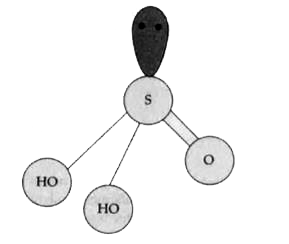 Detailed Answer: (a) (i) (A) In water, the oxygen atom is highly electronegative and can polarize (partially) the hydrogen ATOMS, thus hydrogen-hydrogen bonds between the `H_2O` molecules results in the creation of a stable intermolecular network and the very high boiling point of water and ALCOHOLS. In `H_2S` those bonds don.t exist, because sulphur is much less electronegative. (B) Another reason may be that O uses `sp^(3)` orbitals, and thus alone may be able to form stable hydrogen bonds. By comparison S use p orbitals, which may not be able to form stable hydrogen bonds. (Any other correct justification) (ii) Because it has a strong affinity for water and thus it absorbs water quickly. (b) In sulphurous acid, one atom of sulphur is bonded to two hydroxyl GROUPS and one oxygen atom forms `a pi` bond with the sulphur atom. |
|
| 89446. |
(a) (i) Explain the preparation of Buna-N (ii) Give an example for thermosetting polymer. (b) Name the monomers used in the preparation of polythene and natural rubber. |
Answer» Solution :(a) (i)  (II) Bakelite is thermosetting polymer, (b) Monomer of POLYTHENE is ethane and NATURAL RUBBER ISOPRENE. |
|
| 89447. |
(a) Give reason: (i) Hydrogen bonding in H_(2)O but not in H_(2)S. (ii) Conc. H_(2)SO_(4) is a good dehydrating agent.(b) Give the structure of sulphurous acid (H_(2)SO_(3)). |
|
Answer» SOLUTION :(a)(i) Because in `H_(2)O`, hydrogen is attached to more electronegative oxygen ATOM in `H_(2)O` but not in `H_(2)S`. (ii) Because conc.`H_(2)SO_(4)` removes water molecules from other substances due to its STRONG affinity TOWARDS water. (b) 
|
|
| 89448. |
Explain the preparation of phenol from cumene. |
Answer» Solution :a. (i) Cumene is oxidised in the presences of air to Cumene hydroperoxide, which on treating with dilute acid GIVES phenol and acetone. 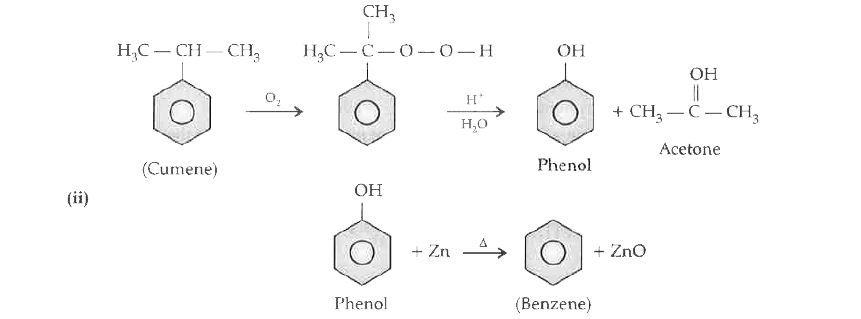 B. Williamson.s synthesis is an important lab method for preparation SYMMETRICAL and unsymmetrical ethers. In this method, an alkyl HALIDES allowed to react sodium alkoxide. `R-x+R.-underset(..)overset(bar(..))(O)-NatoR-underset(..)overset(..)(O)-R.+NaX` Ether containing substituted alkyl groups may also be prepared by this method. |
|
| 89449. |
i) Explain the preparation of Buna-N. ii) Give an example for thermosetting polymer. |
|
Answer» Solution :a) i) BUNA -N is obtained by the copolymerization of 1,3- butadiene and acrylonitrile in the presence of a peroxide catalyst. `underset("1,3-Butadiene")(nCH_(2)=C-CH=CH_(2))+underset("Acrylonitrile")(CH_(2)=CH-CN)overset("Peroxide")rarrunderset("Buna-N")([--CH_(2)-CH=CH-CH_(2)-overset(CN)overset("|")"CH"-CH_(2)--]_(n))` II) BAKELITE. |
|
| 89450. |
a) Give reason: i) Fluorine exhibits only one oxidation state whereas other halogens exhibit multiple oxidation states. ii) Most of the reactions with fluorine are exothermic. |
|
Answer» SOLUTION :i)Fluorine exhibits only one oxidation states whereas other halogens exhibit multiple oxidation states due to absence of d ORBITALS in the valence SHELL ii) Most of the reactions with fluorine are exothermic due to SMALL size and STRONG bond formed by fluorine with other elements. |
|